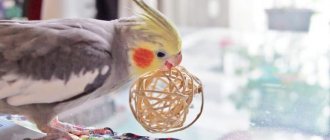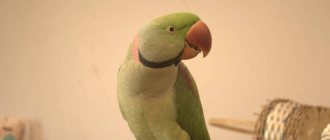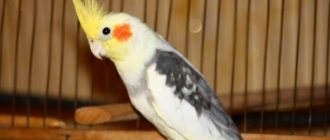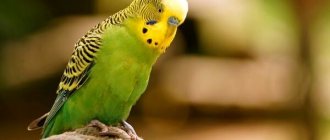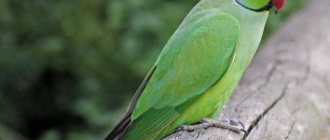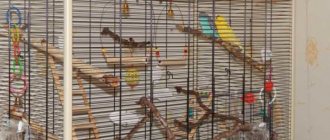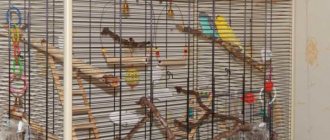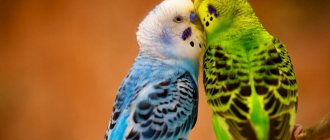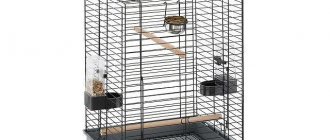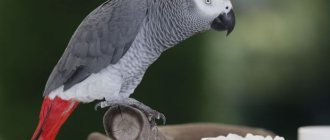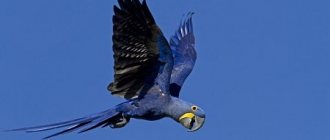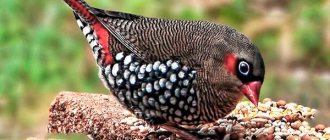Description, characteristics, appearance
Bright overseas birds were brought to Europe from Australia. The number of birds has spread quite quickly; they are actively breeding at home, and not just in the wild. Pets bred by people are perfectly adapted to the life and microclimate of apartments.
Chatty and noisy parrots can even pronounce short phrases. They imitate some sounds and words without understanding the meaning. The slender bird has a long tail. They participate in exhibitions of ornamental birds and win first places.
The length of the bird's wing reaches 10.5 cm. They are used for sitting, flying, and support when walking. In flight, decorative parrots look like swallows. In search of food in nature, parrots fly quite quickly, especially if they are very hungry and need to find food.
Birds of this family have tenacious and developed paws with long fingers of a pinkish, reddish or gray-blue hue. They are able to grab dense parts of food, small food, walk on the ground, or even move through trees. The eye color of wild parrots in the wild can be almost white, yellowish, or dark blue. They even distinguish the color palette.
Cheerful pets have strong beaks. It is covered by a dense stratum corneum. The shape of this bird's nose is similar to those of birds of prey.
With the help of a powerful beak, parrots quickly gnaw through seeds and shoots, and can crush large food. It is also a reliable method of protection against small predators and snakes.
The tongue of budgerigars is thick and short with a keratinized covering, which helps to grind the surface of the beak, break fruits, and clean grains. In the natural landscape, due to the shade of their plumage, parrots remain almost invisible.
The head and crop of birds usually have a yellow tint. He moves to the back area. In the sun, the plumage of budgerigars fluoresces. This way, males quickly attract females for nesting. Birds notice the glow during the day, but people only notice it at night.
I suggest you get acquainted with another type of very beautiful and intelligent parrots in the article Corella parrots: how to keep and care for them at home
Features of the mating season
Before birds mate, a person can observe the mating season, during which the male persistently courts the girl.
The male performs the following actions:
- cleans the female's feathers;
- feeds the girl from his beak;
- regularly sings and dances around the couple;
- shows off in front of the female in different ways, for example, raising its crest and spreading its wings.
If a girl reacts favorably to such methods of courtship, then she will independently show signs of attention, for example, sitting down and caressing the male. Only after this does direct mating begin.
Did your parrots have chicks?
Not really
Where do wild parrots live in nature?
Australia is considered the birthplace of wavy pets. This is the main habitat for wild birds. They mainly live on the east and southwest coasts, where there are the least dense forests. Birds nest in semi-desert areas and steppe zones with sparse trees and shrubs.
They breed in the wild, regardless of the time of year. Parrots live in flocks. On the plains they look for grass seeds, on the green plains they look for water and other food. Birds move quickly and can fly long distances. Today, the transport of wild parrots from Australia is prohibited as the bird population is declining.
Colors of budgies
This ornamental bird, beloved by many, has a variety of plumage colors:
- Cobalt birds first appeared in London at a parrot exhibition in 1910.
- Olive greens were developed in France.
- Yellow parrots are the result of crossbreeding in Belgium.
- Light green is a natural natural color.
- Dark green ones appeared in France.
- Sky blues were bred by Belgian ornithologists.
- Gray-green parrots live in Australia.
- Gray individuals were brought from England and Australia.
- Purple appeared from German breeders.
- Bright yellow parrots (lutinos).
- Albinos with red eyes were bred in Germany in the 40s.
You can distinguish a domestic pet from a wild one by its plumage. Curly parrots with plumage in the form of climbing stems are distinguished. Spangles have a waviness with a mirror reflection, Czechs are distinguished by a fluffy cap and larger sizes.
Chubby or crested birds have crests on their heads of different shapes. Based on the degree of color, birds are classified into single-colored and multi-colored birds. Among them there are penguins, harlequins and birds with a chaotic arrangement of spots.
What do budgies eat?
Basically, all bird breeders buy special mixtures for feeding them. They include sunflower seeds, onion grasses, canary grass, millet, and oats. The product must not contain any chemicals, dyes or expired expiration dates.
Sometimes it is useful to give the bird sprouted oats, just fresh ones each time. The remaining remains are immediately thrown out of the feeder. Ready-made mixtures must be given during hatching, molting, and if the bird is sick.
For good health of wavy birds, the following is introduced into their diet:
- clean branches of fruit trees;
- pumpkin, carrots, beets;
- peaches, pears, plums;
- strawberries, kiwi, apples;
- boiled chopped eggs and cottage cheese.
Be careful when giving special cereal sticks for birds or honey crackers. Fruits and vegetables are given fresh and pure. Vitamins are administered only during feeding of offspring, illness, severe stress or molting.
It is forbidden to give the bird alcohol and chocolate, sweet candies, rhubarb and potatoes, milk and kefir. Parrots are often poisoned by home ornamental plants. In order for their digestion to occur normally, it is necessary to pour clean sand into the cage.
It is useful to give flaxseed, rice porridge, buckwheat, wheat or rye to birds at home. They are boiled without adding salt. Fresh corn, grapes, banana, clover grass, dandelion grass, and wood lice are suitable as top dressing.
How do budgies reproduce?
In captivity, birds of this family live 10-15 years. Before nesting in nature, the female chooses a male. She is usually attracted by the color features of a male representative and the ability of his feathers to fluoresce under the influence of sunlight.
In Australia, the female incubates the chicks twice during the year. Pets should have long breaks before nesting. Under natural conditions, wavy fish live in rock crevices or tree hollows.
A house with straw bedding is set up for pets. On average, the female lays 3-5 eggs at a time. Sometimes 10-12 pcs. She incubates them for 20 days. At this time, the male obtains and brings food. The chicks are born blind and naked.
After a few weeks, their body is covered with dense fluff. After a month, feathers appear. Normal plumage is formed no earlier than 3 months of age. You should not buy a younger bird. Genetic diseases will appear after the first molt.
Nesting
Before they begin to reproduce, parrots look closely at each other. If they don’t fight, they play, then you can expect a replenishment soon. The male begins to court the female. He chirps loudly, takes various poses, cleans his partner’s feathers and brings her food.
You can tell that a female is ready to breed by her behavior. She tries to constantly be close to the male and responds to his advances. Parrots usually reproduce unnoticed by their owners.
If mating was successful, then after a few days the female will begin to build a nest. First, she will examine the house from all sides, and then she will begin to restore order in it. She builds a nest from dry grass, sawdust and thin twigs.
Setting up a cage for a budgie
A feathered pet should live in a spacious and clean cage. The norm for one parrot is 30 cm width, 35 cm height and 40 cm length. It is better to take a large aviary or a cage twice as large so that the bird can fly a little inside.
Inside there should be different perches made of wood, not plastic. This is important for grinding down the claws on the paws. Plastic perches that are too thick or thin can cause deformed birds' toes and claws, calluses and calluses.
There must be fresh water in the nest of the wavy; it is poured daily into a special fixed drinking bowl. The grain mixture is poured into the feeder. There is a separate container for mineral supplements and soft food. A stone is attached to one side to grind down the beak. Parrots love toys - ropes, swings, bells. To make cleaning up after your pet faster and easier, the cage is equipped with a deep retractable tray.
Wash the bird's cage with baking soda and warm water. No cleaning agents are used. It is better to let your feathered friend out of his cage every day and fly around the room. It is first ventilated, but then the vents and windows are closed.
They are covered with curtains to prevent the bird from hitting the glass. All indoor plants are also removed so that the budgie does not get poisoned by them. Feathered pets love water treatments. They are regularly given a bath with water, and the birds in the cage are sprayed with a spray bottle during hot weather.
The appearance of offspring
The chicks hatch 18 days after the last egg appears. They break the shell and get out. The female helps them free and sometimes eats the shell.
Babies are born naked and blind, and their weight is only 1-2 g. At first, the chicks constantly lie down and do not hold their heads up. During the first days they feed on crop milk, which the mother releases into their beak.
Important! Budgerigar chicks do not hatch at the same time and grow very quickly. By the time the last cub appears, the first ones become quite large and can injure the baby. To prevent this from happening, the breeder should check the nest frequently.
How to choose a wavy pet
Experts recommend buying a pet for 3-4 months. An adult parrot will take a long time to adapt and may even get sick. It is better to give preference to parrot breeders who keep their pets in the right conditions. In markets you can come across unhealthy poultry.
A healthy bird has dense feathers that are clean and shiny. The paws have even scales. A sick individual is sedentary, indifferent to others, often unkempt, with dull and ruffled feathers.
It is important to remember before purchasing that birds love to sing and can do this very early in the morning. They litter a lot - with paper scraps, feathers, droppings, and food husks. You will have to clean and clean the cage every day to prevent the unpleasant smell of feces from appearing.
Lovers of indoor flowers should move their plants to another room. The bird can taste the soil, gnaw leaves, and then pick up helminths.
Near the parrot and in this room where it lives, you cannot smoke, spray perfume, air fresheners, paint your nails, or cook food. The delicate respiratory system of the wavy can be seriously damaged by this.
Where to start
It is important to immediately understand that the bird does not understand the meaning of the words. It can only imitate a certain sequence of sounds of human speech, which is why systematic repeated repetition is so important. Do not give your parrot too difficult tasks at once, such as learning a long phrase. Start with 2-3 short words. Alternate them. Keep in mind that the parrot may simply not like some words, and therefore he will not repeat them.
Advice. Parrots find it easier to learn words that contain the sounds “r”, “p”, “k”, “t”. "sh", "ch". It is with these words that it is better to start learning. The simplest example is the words “hello”, “guard”.
The main thing in the learning process is systematicity. If you only work with your parrot “when the mood strikes,” it won’t do any good.
- Classes should be daily.
- Several lessons are taught per day (on average 2-3), preferably at the same agreed time.
- One lesson can last from 10 to 40 minutes, as long as your pet’s attention span is sufficient. Once he loses interest, the lesson is over.
Do not forget to repeat the material you have covered - birds tend to forget what they have learned without practice, just like people.
To teach your pet to speak, exercise regularly.
What do budgies get sick with?
Very often, decorative parrots suffer from colds. They begin to sneeze and sniffle. Their feathers are often infested by lice beetles and mites. This causes feather loss and itching. If the bird has lost its appetite and looks lethargic, it is quite possible that it has picked up worms. It is necessary to check your budgerigar's cloaca periodically, especially during the breeding season.
Sick birds are treated with anthelmintic agents, chamomile decoction, vitamin preparations, tick sprays, and a lamp is sent to disinfect the cage.
The earlier the better
The speed and success of the learning process depends on several factors.
- Age. The younger the bird, the easier it is to train. It is recommended to start training small parrots (like budgies and cockatiels) at the age of 1-2 months. If the bird is already an adult, teaching it to speak will be more difficult.
- Paula. Males are easier to train than females, especially budgies. Sometimes you can even hear the opinion that females are not trainable at all, but this is not entirely true, the pedagogical process will simply be longer. By the way, according to experts, if females start talking, they pronounce the words more clearly than males.
First of all, establish a trusting relationship with the bird. - Factor of “psychological comfort”. The parrot should have confidence in you. That is, do not express concern when you approach the cage, take food from your hands without fear, sit on your hand or shoulder, show interest in interacting with you (and not only in receiving food).
- Favorable conditions. First of all, this is the absence of distractions during the lesson. Make sure that there is no noise or fuss around that will occupy the parrot’s attention. If you have several birds, it is better to isolate the “student” from his fellow birds for the duration of the lessons.
Important! Birds perceive high-pitched voices better, so they quickly remember and reproduce words spoken by women or children.
How to best care for a budgie
Stress for a bird is moving to a new habitat. At this time, it is better not to turn on the TV loudly and remove other pets that will disturb your feathered friend. At night, some breeders cover the cage with a thin sheet, making several slits for air to enter.
On warm days, you can expose your bird cage to the sun to help produce vitamin D. Parrots usually molt twice a year. They feed her with vitamins and try not to disturb her. You can occasionally add ascorbic acid or lemon juice to the water.
It doesn't need to be boiled. Regular filtered or bottled water will do. Once a month, a general cleaning is carried out in the feathered pet’s house, wiping it with water, a decoction of wormwood or chamomile.
Temperature conditions and suitable lighting
In the room where your wavy friend lives, it is important to maintain favorable temperature conditions, microclimate and lighting. Do not place the cage with pets in a draft or direct sunlight, or near hot radiators. The suitable temperature for poultry is 20-22 degrees. Humidity – 60%.
The light regime is also very important so that the bird can sleep and rest peacefully. The parrot is taken out onto the balcony in spring and summer on cool days. In this case, you can throw a light tulle over the cage or create an area with shadow.
